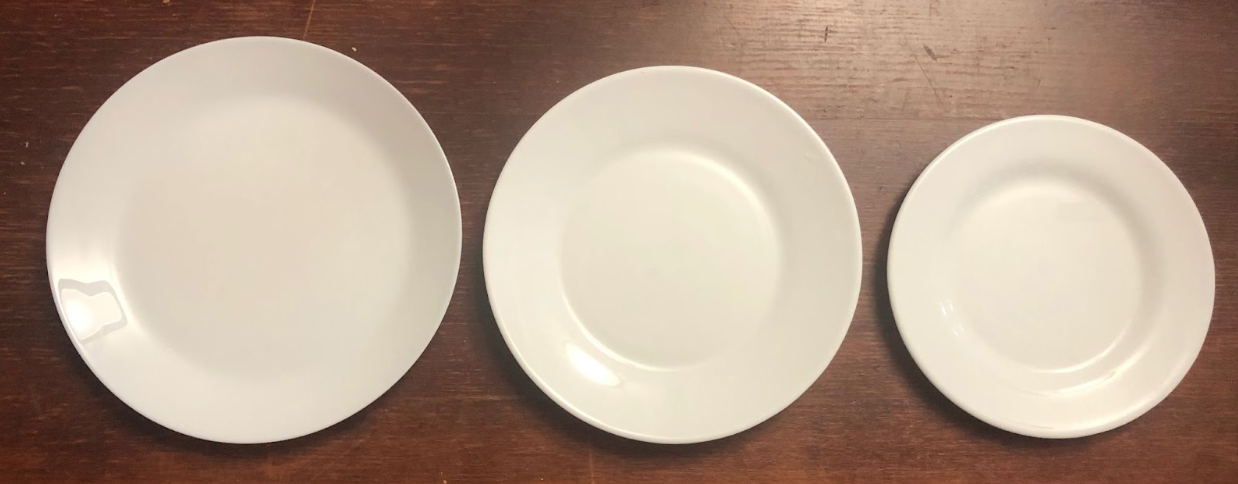Content warning: This article contains references to eating disorders.
I am concerned about the downsizing of plates in the dining hall. As someone who has struggled with an eating disorder and has many friends who have struggled with eating disorders on this campus, interventions like these make recovery harder. This kind of behavioral nudge presents a serious community health issue.
The new dining hall plates this year are tiny. They have an eight-inch diameter, compared to standard dinner plates that have 10-inch or 11-inch diameters. This means that the new plates have about 60% of the area of a standard plate.
People eat less food when provided with smaller plates. One study published in the Food Quality and Preference Journal asked participants to draw the amount of food they expected to eat for dinner on two different plate sizes. On average, they drew 24% more food on larger plates.
These results have been corroborated time and time again. Another study published in the American Journal of Preventative Medicine found that nutrition experts given larger bowls served themselves 31% more ice cream. As Bryan Wansink, professor of consumer behavior at Cornell, wrote, plate size “can subtly suggest how much food is reasonable, normal, typical and appropriate for us to be serving ourselves and consuming.”
This perception leaves people thinking they have eaten enough food, or even too much food, when they haven’t. For this reason, “use smaller plates” is common dieting advice.
The amount of food that can fit on the new dining hall plates is not enough for a meal for me — a semi-active, five-foot-four woman with a medium metabolism. This amount of food is also not enough for many of my friends, with one exclaiming, “Oh! That’s why I’m so hungry,” an hour after dinner when I brought up the small plates.
The default meal plan amounts to around two swipes per day, and there is little to no access to free food between meals for most students on campus, so not eating enough at one meal affects students throughout the day.



An obvious workaround would be for students to take multiple plates if they need more food. However, people struggling with restrictive eating disorders likely will stop themselves from getting another plate, thinking that needing more than one plate worth of food means they have failed, makes them fat or means they are overeating (this is an eating disorder recovery blog post reframing getting seconds).
Even for people without formally diagnosed eating disorders, there is a stigma associated with getting seconds or taking multiple plates of food.
Eating disorders are commonplace among college students. Between 10 and 20% of women and 4 to 10% of men in college currently suffer from an eating disorder, according to the Child Mind Institute. Residential & Dining Enterprises (R&DE) should be taking steps to ameliorate this alarming prevalence, especially because eating disorders have the highest mortality rate of all psychological conditions. With the known ubiquity of disordered eating on this campus, Stanford Dining has no excuse for forcing the student body to follow dieting advice.
In addition to harming students who struggle with disordered eating, small plates can aggravate other existing problems.
- Limited swipes, exacerbated by small plates when students are more likely to accidentally leave a meal hungry, cause stress to people who have dealt with food insecurity. Larger plates will not fix everything, but they will at least not be a regression away from helping these communities.
- Since many people are getting multiple plates, smaller plates result in more work for the dishwashers and dining hall workers, who are probably not seeing a pay increase due to the change in plate size.
- Small plates are an accessibility issue: bigger plates can be used to perch glasses and bowls on the side for people who only have mobility or strength in one arm or otherwise only have the ability to carry one item at a time. I have a broken arm that has kept me from getting two plates when I need to. There are other people with much more long-lasting and salient accessibility concerns in this regard. Since we don’t have trays in the dining hall, people need to use plates to balance bowls and cups.
- Small plates are an allergy issue: People are resorting to piling food items one on top of the other to fit them all on the plate. This piling is more likely to result in serving tong contamination than if there were clean space on the plate to put new food items.
I am sure that this change was instituted with good intentions, maybe as a food waste prevention program or to save costs on food in the dining halls. While it can be argued that portion control is an important life skill, I firmly believe that protecting college students who are particularly vulnerable to disordered eating is more important. And there are other ways to prevent food waste that don’t result in hungry students struggling with whether to go back for seconds.
- Education about food waste can help.
- Having some food available outside of dining hours (cereal, etc.) could lead to less of a scarcity mindset. This food availability could keep people from putting more than they can eat on their plates or gorging themselves to prevent getting hungry between meals (something I did many times before living in a co-op where we always have food available).
I don’t know all of the solutions, but intentionally restrictive plates are not a viable option.
Eliana Fuchs wrote this article.
Cameron Lange, Vai Crevoisier and Elena Sierra contributed to this article.
